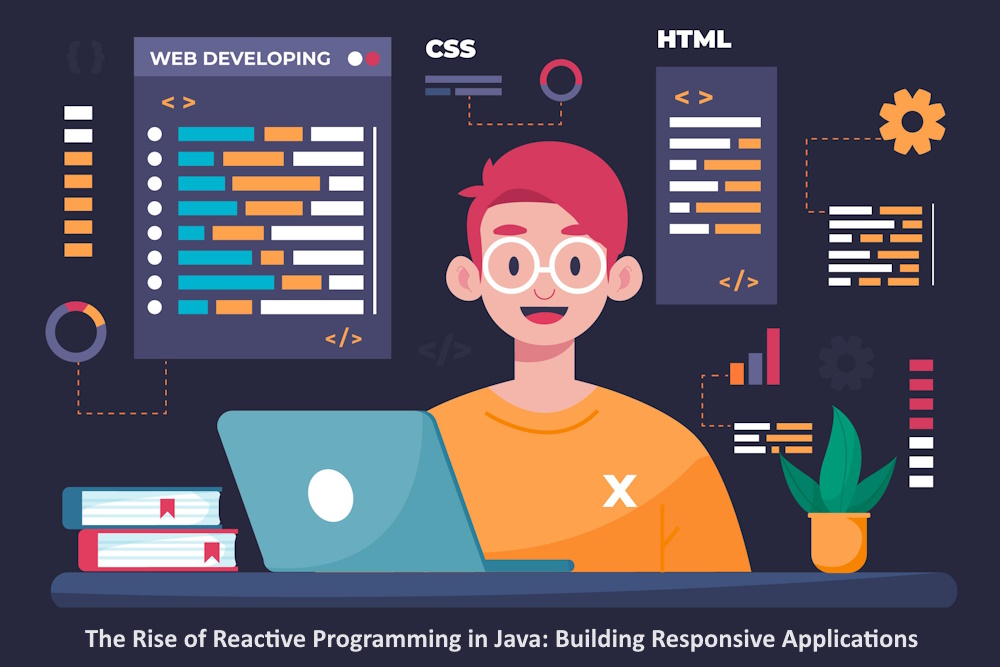As software development paradigms evolve, reactive programming is burgeoning in popularity, particularly in the realm of Java programming. This technique, which emphasizes non-blocking, asynchronous data streams, empowers developers to create highly responsive applications that thrive in the modern web ecosystem.jh
Contents
What is Reactive Programming?
At its core, reactive programming is an architectural principle centered around data flows and the propagation of change. It facilitates seamless management of data streams and the propagation of changes, allowing applications to remain responsive under varying load conditions. Reactive programming leverages asynchronous I/O operations, ensuring the application remains non-blocking and can efficiently handle multiple simultaneous requests.
Reactive programming’s rise in Java can be attributed to the introduction of Reactive Streams in Java 9 and its subsequent adoption by popular frameworks such as Spring WebFlux. These frameworks use reactive programming principles to handle high volumes of traffic effectively, making them ideal for building resilient, scalable, and responsive microservices. With these tools, Java developers can embrace the reactive paradigm, creating applications capable of meeting the demanding requirements of today’s cloud-native environments.
Reactive Programming in Java
Java, with its robust toolset and mature ecosystem, is embracing the reactive programming paradigm with open arms. The addition of the `java.util.concurrent.Flow` API in Java 9 marked the formal inclusion of reactive programming constructs in the language. The Flow API includes interfaces such as `Publisher`, `Subscriber`, `Subscription`, and `Processor`, providing the base for asynchronous flow-controlled computation in Java.
Key Benefits of Reactive Programming in Java
- Efficient Resource Utilization: Reactive programming allows Java applications to efficiently manage system resources. It enables applications to handle a high number of concurrent users and processes, making the system more scalable and responsive.
- Improved User Experience: By facilitating non-blocking and asynchronous operations, reactive programming in Java enhances application responsiveness, leading to a better user experience.
- Robust Error Handling: The reactive approach includes robust error handling mechanisms, allowing developers to build resilient applications that can maintain their performance even when unexpected errors occur.
- Enhanced Development Process: Reactive programming can lead to an improved development process. With the ability to handle data streams more efficiently, it can make coding more straightforward and less prone to errors.
The Role of Project Reactor and Spring WebFlux
The rise of reactive programming in Java is closely intertwined with the emergence of libraries like Project Reactor and frameworks like Spring WebFlux.
Project Reactor is a fully non-blocking reactive programming foundation for the JVM, providing efficient demand management (backpressure-ready) capabilities. It offers two main types of publishers: `Flux` (representing 0 to N items) and `Mono` (representing 0 to 1 item), simplifying the development of reactive applications.
Spring WebFlux, on the other hand, is a non-blocking web framework built to take advantage of multi-core, next-generation processors, and to handle concurrency with a small number of threads. It’s part of the larger Spring 5 framework and a counterpart to the Spring MVC. WebFlux introduces a new style of programming—reactive programming—and is designed to work with Project Reactor and its publisher implementations.
- Embracing the Reactive Paradigm: Reactive programming in Java has become more prevalent with the introduction of the `java.util.concurrent.Flow` API. This shift towards a more reactive approach offers a more efficient handling of computational resources.
- Role of Project Reactor: Project Reactor plays a crucial role in the propagation of reactive programming in the JVM environment. It provides efficient demand management and offers essential publisher types (`Flux` and `Mono`) that streamline the development of reactive applications.
- Introduction of Spring WebFlux: As part of the larger Spring 5 framework, Spring WebFlux introduces a non-blocking, reactive programming style. It’s designed to harness the power of multi-core processors, efficiently managing concurrency with a small thread count, and integrates seamlessly with Project Reactor.
The Implications of Reactive Programming
By leveraging reactive programming in Java, developers engaged in Java software development can create highly responsive applications that can serve many clients concurrently. Reactive applications, designed with the principles of Java software development, are resilient and elastic. They can easily scale up and down to match demand, making them well-suited to the dynamic scaling environment of the cloud.
- Reactive Programming promotes a non-blocking, event-driven approach for data processing, leading to better usage of computational resources.
- Libraries like Project Reactor offer a foundation for the JVM, providing efficient demand management.
- Spring WebFlux, a non-blocking web framework, is built to take full advantage of modern multi-core processors and handle concurrency with a small number of threads.
- Reactive applications are ideal for cloud environments due to their ability to scale easily in response to demand.
- Due to their resilience and elasticity, reactive applications can maintain high performance even under heavy load or failure scenarios, ensuring a consistent user experience.
Furthermore, reactive programming makes the application code more readable and easier to understand. By expressing complex operations as a pipeline of simple steps, it reduces the risk of errors and enhances maintainability.
Conclusion
Reactive programming is undeniably shaping the future of Java, enabling developers to build efficient, scalable, and resilient applications. With the support of modern frameworks and libraries, Java developers are well-equipped to harness the reactive paradigm’s full potential, making Java a language of choice for creating reactive applications. As we move towards an increasingly connected world, the demand for responsive applications will only grow, solidifying the place of reactive programming in Java’s future.




